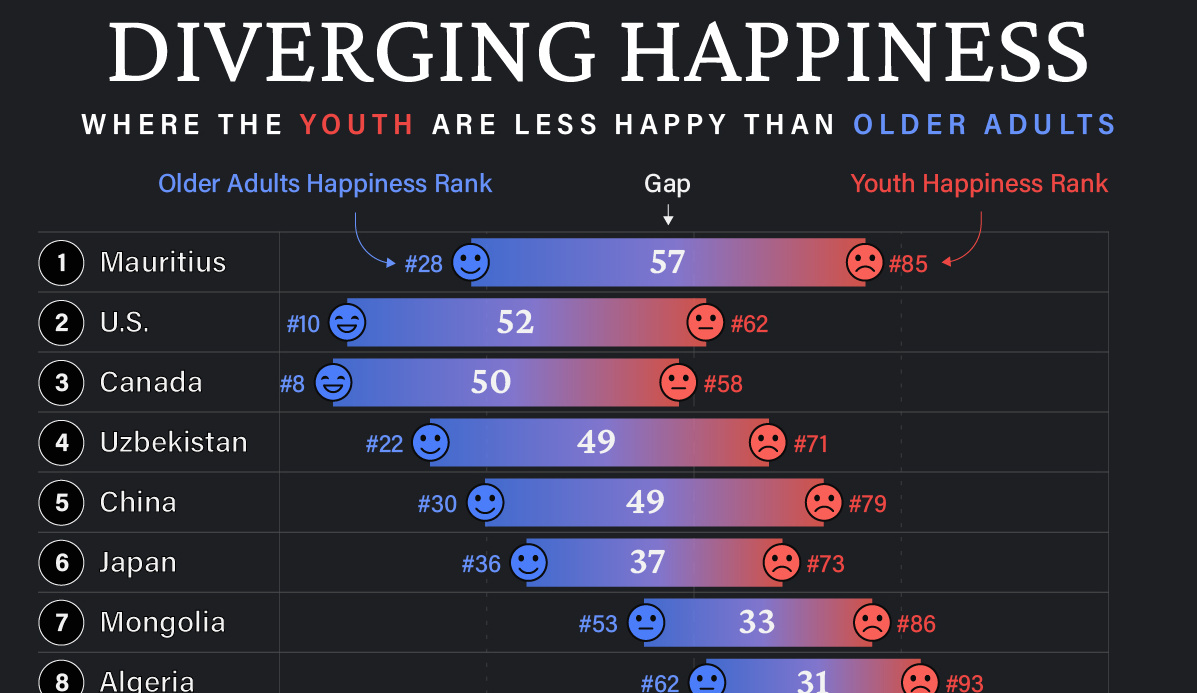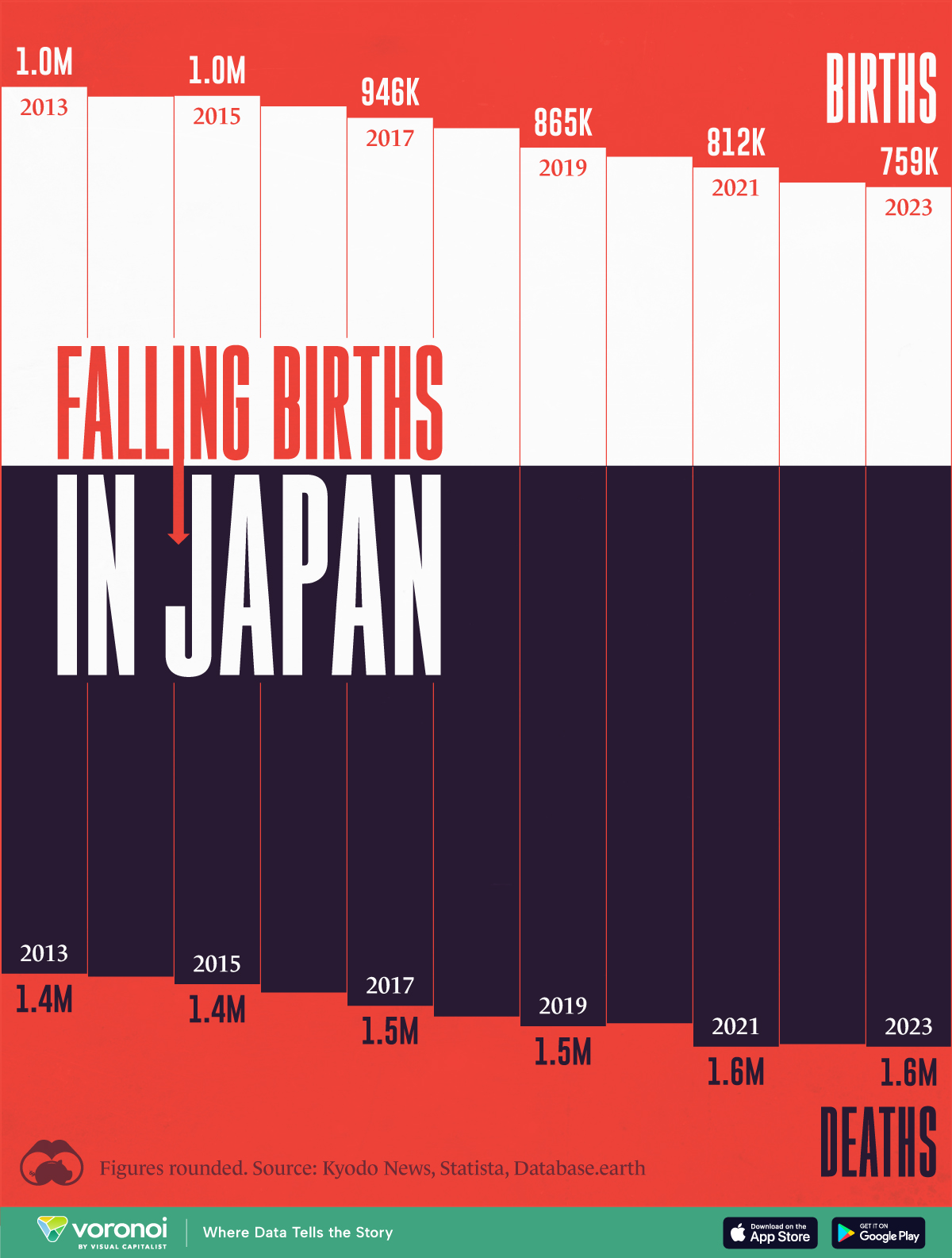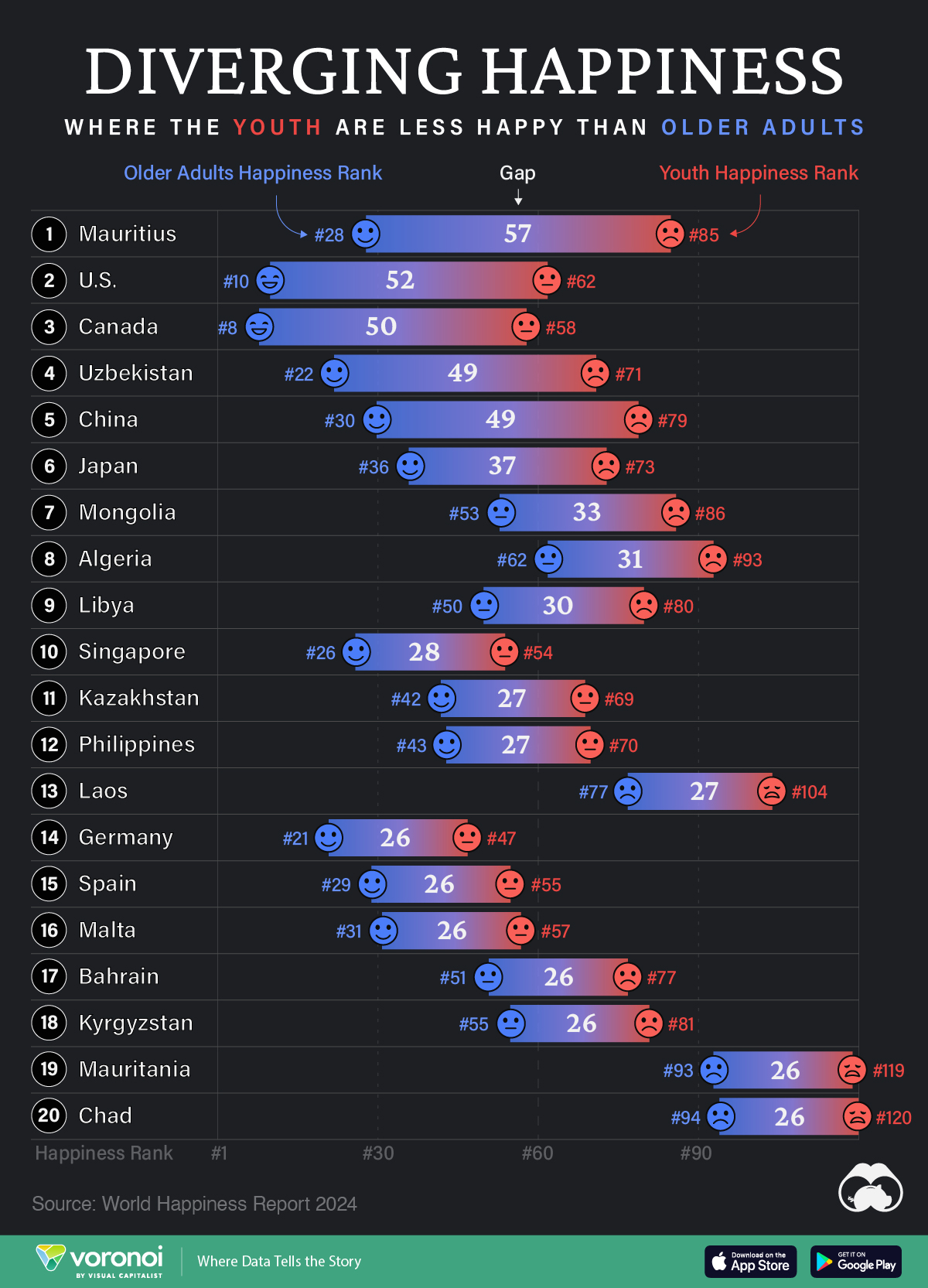Demographics
Visualizing the Declining Birth Rate in Japan
![]() See this visualization first on the Voronoi app.
See this visualization first on the Voronoi app.
Visualizing the Declining Birth Rate in Japan
This was originally posted on our Voronoi app. Download the app for free on iOS or Android and discover incredible data-driven charts from a variety of trusted sources.
Japan’s birth rate has been declining over the last three decades. While Japan’s population was 123.3 million in 2023, it is expected to decrease by approximately 29.4% to 87.0 million by 2070.
In this graphic, we use data from Kyodo News, Statista, and Database.earth to illustrate the number of live births each year in Japan, compared to the number of annual deaths. Figures were rounded.
Population Shrunk by Largest Margin Ever in 2023
Declining births and increasing deaths resulted in Japan’s total population falling by 831,872 people in 2023.
| Year | Births | Deaths |
|---|---|---|
| 2013 | 1,029,817 | 1,376,554 |
| 2014 | 1,003,609 | 1,384,931 |
| 2015 | 1,005,721 | 1,405,072 |
| 2016 | 977,242 | 1,428,060 |
| 2017 | 946,146 | 1,463,873 |
| 2018 | 918,400 | 1,493,140 |
| 2019 | 865,239 | 1,519,227 |
| 2020 | 840,835 | 1,511,209 |
| 2021 | 811,622 | 1,574,533 |
| 2022 | 770,759 | 1,567,933 |
| 2023 | 758,631 | 1,574,865 |
The National Institute of Population and Social Security Research once estimated that births would decline to below 760,000 in 2035.
With births in 2023 recorded at 758,631, this forecast was off by over 10 years.
Meanwhile, the number of deaths has increased over the last 10 years, surpassing 1.5 million in 2023, equivalent to 1.22% of the population.
Many younger Japanese hesitate to marry or start families due to bleak job prospects, corporate cultures unsupportive of working parents—especially women—and a lack of public tolerance for small children, as reported by the Associated Press. Rising costs also contribute to couples’ reluctance to have children.
The average number of children a woman gives birth to in her lifetime in Japan hit 1.26 in 2022. The fertility rate is far below the replacement rate of 2.1 considered necessary to maintain a population without immigration.
One of the biggest concerns is that a shrinking and aging population can have significant implications for the economy and national security.
As a result, Japan’s government is taking steps to cope with the declining birthrate, such as expanding childcare and promoting wage hikes for younger workers.
Countries
Ranked: Countries Where Youth are the Most Unhappy, Relative to Older Generations
Conventional wisdom says that young adults (those below 30) tend to be the happiest demographic—but this is not true for these countries.

Countries with the Biggest Happiness Gaps Between Generations
This was originally posted on our Voronoi app. Download the app for free on iOS or Android and discover incredible data-driven charts from a variety of trusted sources.
“They say a person needs just three things to be truly happy in this world: someone to love, something to do, and something to hope for.” — Tom Bodett
Measuring happiness is tricky business, more so when taking into account how different regions, cultures, and faiths define it. Nevertheless, the World Happiness Report attempts to distill being happy into a single score out of 10, and then ranks countries by their average score.
We’ve visualized the high-level findings from the latest happiness report in this series of maps. However, the report also dives deeper into other significant trends in the data, such as a growing disparity in happiness between age groups within countries themselves.
In the chart above, we list countries by the biggest gaps in happiness ranks between young adults (<30) and older adults (60+). A higher number indicates a larger gap, and that the youth are far unhappier than their older counterparts.
Where are Youth Unhappier than Older Adults?
Mauritius ranks first on this list, with a massive 57 place gap between older adult and youth happiness. The 1.26 million-inhabited island nation briefly reached high income status in 2020, but the pandemic hit hard, hurting its key tourism sector, and affecting jobs.
The country’s youth unemployment rate spiked to close to 25% that year, but has since been on the decline. Like residents on many similarly-populated islands, the younger demographic often moves abroad in search of more opportunities.
| Rank | Country | Youth Happiness Rank | Older Adult Happiness Rank | Happiness Gap |
|---|---|---|---|---|
| 1 | 🇲🇺 Mauritius | 85 | 28 | 57 |
| 2 | 🇺🇸 U.S. | 62 | 10 | 52 |
| 3 | 🇨🇦 Canada | 58 | 8 | 50 |
| 4 | 🇺🇿 Uzbekistan | 71 | 22 | 49 |
| 5 | 🇨🇳 China | 79 | 30 | 49 |
| 6 | 🇯🇵 Japan | 73 | 36 | 37 |
| 7 | 🇲🇳 Mongolia | 86 | 53 | 33 |
| 8 | 🇩🇿 Algeria | 93 | 62 | 31 |
| 9 | 🇱🇾 Libya | 80 | 50 | 30 |
| 10 | 🇸🇬 Singapore | 54 | 26 | 28 |
| 11 | 🇰🇿 Kazakhstan | 69 | 42 | 27 |
| 12 | 🇵🇭 Philippines | 70 | 43 | 27 |
| 13 | 🇱🇦 Laos | 104 | 77 | 27 |
| 14 | 🇩🇪 Germany | 47 | 21 | 26 |
| 15 | 🇪🇸 Spain | 55 | 29 | 26 |
| 16 | 🇲🇹 Malta | 57 | 31 | 26 |
| 17 | 🇧🇭 Bahrain | 77 | 51 | 26 |
| 18 | 🇰🇬 Kyrgyzstan | 81 | 55 | 26 |
| 19 | 🇲🇷 Mauritania | 119 | 93 | 26 |
| 20 | 🇹🇩 Chad | 120 | 94 | 26 |
Conventional wisdom says, and data somewhat correlates, that young adults (those below 30) tend to be the happiest demographic. Happiness then decreases through middle age and starts increasing around 60. However, the above countries are digressing from the pattern, with older generations being much happier than young adults.
That older generations are happier, by itself, is not a bad thing. However, that younger adults are so much unhappier in the same country can point to several unique stresses that those aged below 30 are facing.
For example, in the U.S. and Canada—both near the top of this list—many young adults feel like they have been priced out of owning a home: a once key metric of success.
Climate anxieties are also high, with worries about the future of the world they’ll inhabit. Finally, persistent economic inequities are also weighing on the younger generation, with many in that cohort feeling like they will never be able to afford to retire.
All of this comes alongside a rising loneliness epidemic, where those aged 18–25 report much higher rates of loneliness than the general population.
Source: The World Happiness Report which leverages data from the Gallup World Poll.
Methodology: A nationally representative group of approximately 1,000 people per country are asked to evaluate their life on a scale of 0–10. Scores are averaged across generations per country over three years. Countries are ranked by their scores out of 10.
-

 Personal Finance1 week ago
Personal Finance1 week agoVisualizing the Tax Burden of Every U.S. State
-

 Misc6 days ago
Misc6 days agoVisualized: Aircraft Carriers by Country
-

 Culture6 days ago
Culture6 days agoHow Popular Snack Brand Logos Have Changed
-

 Mining1 week ago
Mining1 week agoVisualizing Copper Production by Country in 2023
-

 Misc1 week ago
Misc1 week agoCharted: How Americans Feel About Federal Government Agencies
-

 Healthcare1 week ago
Healthcare1 week agoWhich Countries Have the Highest Infant Mortality Rates?
-

 Demographics1 week ago
Demographics1 week agoMapped: U.S. Immigrants by Region
-

 Maps1 week ago
Maps1 week agoMapped: Southeast Asia’s GDP Per Capita, by Country















